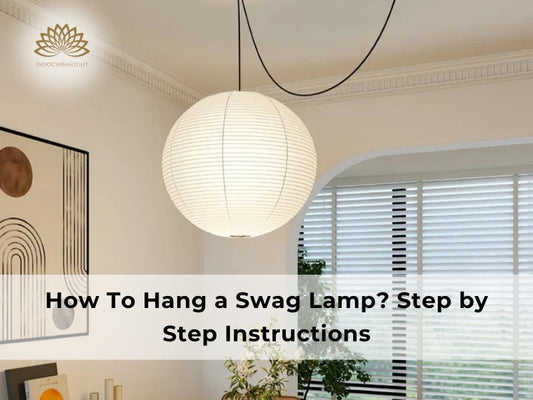Selecting the right lamp shade is crucial to achieving the perfect ambiance in a room. The right size and style can enhance the lamp's functionality and aesthetics. The lamp shade's size impacts how much light is distributed, the overall visual appeal, and how well it complements the lamp base and surrounding décor.
Start by measuring the width of the top of your lamp shade with a yardstick or measuring tape, followed by the bottom width. If your shade is rectangular, be sure to measure both widths. For round shades, lay the measuring tape across the top and measure from one edge to the other, aiming for the center as much as you can.

This article provides step-by-step instructions on measuring a lampshade correctly, including guidance for different lamp types and styles. After reading, you'll know exactly how to determine the proper dimensions for your lampshade to ensure perfect proportion and lighting efficiency for your space.
Lamp Shade Measurement Guidelines
When selecting a lampshade, you must measure four key dimensions. Use the following method to measure your lampshade.
-
Top Diameter: The top diameter is measured across the top of the shade. For round or square shades, simply measure the distance across the top. For rectangular or oval shades, measure the top's length and width.
-
Bottom Diameter: The bottom diameter is measured similarly to the top diameter. For round or square shades, measure across the bottom. For rectangular or oval shades, measure the bottom's length and width.
-
Height: The height of the shade should be measured straight down, not following its slant. This is a direct vertical measurement from the top edge to the shade's bottom edge. The height is crucial to ensure the shade covers the hardware properly and doesn't overwhelm or underwhelm the lamp base.
-
Side: The side (or height) is the vertical measurement from the top of the shade to the bottom, typically following the slant if the shade is tapered. The side measurement will be longer than the height for lamps with a steep slant. Following the slant is essential if the top is smaller than the bottom.

A guide to measuring a lampshade, detailing top and bottom diameters, height, and side dimensions for proper fit.
Specific Lamp Shade Measurements
Different types of lamps require different shade proportions. Here, we'll cover the two main types of lampshades: table lamps and floor lamps.
Table Lamp
For table lamps, the shade should be about two-thirds the height of the lamp base. For example, if the lamp is 16.5 inches high, the shade height should be between 9.9 inches and 11.5 inches.
The diameter is typically matched to the lamp's height for table lamps. If the lamp is 10 inches tall, choose a shade between 8 and 12 inches wide. If the lamp is taller, the width range should increase accordingly.
Suitable lampshade size ratio for table lamps
Floor Lamp
For floor lamps, the shade should be roughly one-fourth the height of the lamp base. For instance, if the lamp stands 35 inches tall, the shade should be between 8.75 inches and 14 inches.
For floor lamps, the width of the shade is often twice the width of the lamp base. For example, if the floor lamp's base is 10 inches wide, the shade should ideally be around 20 inches in diameter.
Suitable lampshade size ratio for floor lights
Choosing the Right Lamp Shade
There are four key factors to consider when choosing the right lampshade:
-
Lampshade Color: The color of the lampshade should harmonize with the room's color scheme. Neutral tones like white, cream, and grey provide a classic look, while bolder colors can make a statement and draw attention.
-
Lampshade Shape: The shade's shape should complement the lamp base's design. Drum shades are ideal for modern, minimalist spaces, while Tapered shades are perfect for more traditional settings. A taller cylinder shade adds sophistication and works well with sleek, contemporary designs.
-
Lampshade Material: Lampshades are made from various materials that influence their overall style and the light they emit. Common materials include linen, silk, paper, fabric, glass, and natural materials like seagrass. Thicker materials like linen, silk, or fabric will diffuse light less and create a more focused, mood-setting glow, while glass and translucent materials provide a soft, ambient light.
-
Patterns and Texture: Choose a shade with a plain, subtle texture or bold pattern depending on the lamp's style and room decor. A bold, patterned shade can add personality to minimalist or modern lamps. A simpler shade that doesn't distract from the design is often more appropriate for ornate lamps.

Considerations When Choosing The LampShade
There are four essential factors to consider when selecting the perfect lampshade:
-
Types of Lamp Shade Fittings: There are different fittings for attaching lamp shades to lamp bases: Spider fittings attach to a U-shaped saddle near the socket and are secured by a finial on top. Uno fittings are simpler and screw directly onto the socket, with the bulb inserted afterward. Clip-on fittings are used for candelabra-style bases.
-
Wattage: Lampshades often have their wattage ratings, which should not be exceeded regardless of the max allowable wattage of the lamp—a table lamp rated for 150 watts paired with a shade rated for 75 watts must use a bulb with a wattage no greater than 75. LED bulbs can help you get around this requirement since they offer the same illumination level at much lower wattages (and save energy, too!).
-
Illumination: The shade you choose will affect how bright the lamp is. Shades of light colors and fabric will usually allow light to pass through the shade, increasing illumination. Shades in dark colors, tight weaves, or opaque materials only allow light to shine out of the top and bottom and so are more suited to use as mood lighting or accent lighting in rooms with other fixtures.
-
Shade Position: The bottom of the shade should fall at eye level to avoid annoying glares. If you intend to use the lamp next to your sofa, the shade should block the light when sitting on the sofa. Only about half the neck of the shade should be visible, with no harps or sockets showing. You may need a new harp that fits your new shade to get this positioning right!

Conclusion
Selecting the right lamp shade is crucial for both functionality and aesthetics in your home. This article has provided comprehensive guidance on measuring lampshades correctly, ensuring you can find the perfect fit for any lamp in your space.
We've covered essential topics, including lamp shade measurement guidelines, specific measurements for different lamp types, and factors to consider when choosing a lampshade, and answered frequently asked questions about lamp shade sizing and fittings.
At IndochinaLight, we offer a wide range of handcrafted rattan and bamboo pendant lights that bring natural elegance to any room. Our artisanal approach ensures each piece is unique while providing the perfect lighting solution for your space.
IndochinaLight - IndochinaHomeDecor LLC
-
Address: 30 N Gould St Ste. N, Sheridan, WY 82801
-
Phone: (+)1 307 249 0594
-
Email: service@indochinalight.com
Frequently Asked Questions (FAQs)
How do you determine the size of a lampshade?
If you're unsure what shade will suit your lamp, a general rule of thumb is to measure the height of the lamp base – from the bottom to the top of the bulb fixture – then divide this by four. This will give you an average height for the size of shade you'll need.
How do I know my shade size?
Lamp shade measurements are listed in three main dimensions: top, bottom, and Side. If a lampshade is round or square, one number will be listed for each dimension. Rectangular or oval shades will typically have the length and width listed for the top and bottom dimensions.
How to measure for a lampshade calculator?
The width of your lampshade should be at least 2x wider than the widest part of your lamp's base. Calculate the optimal width by multiplying the measurement of your lamp base's widest part by 2. For example, a table lamp with a base of 5 inches should have a lampshade at least 10 inches in diameter.








